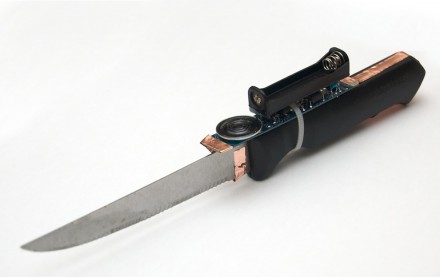After weeks of planning and giddy anticipation, my course is underway! Here’s my recap of the first two weeks of the course. I plan on making the course materials available eventually, but I want to tidy them up and clarify them before I do. If you’re interested, please check back or subscribe to the site feed.
Week 1
The plan for the first week was to cover the fundamentals of electric circuits that we’ll need for the course: a definition of electricity, how to use a breadboard to test circuits, how to use a multimeter, and some basic electrical theory (for those of you more technically inclined, Ohm’s Law and Kirchoff’s Laws, but the latter just descriptively and not mathematically).
The plan was a little ambitious, and I was not nearly as eloquent a teacher as I had imagined myself being; there were some pretty fundamental ideas that I just didn’t explain well enough, and as a result there was much more confusion than I would have liked.
That said, there was more than a little silver lining: first of all, my students are bright and enthusiastic enough that they pulled through, undeterred, in spite of any pedagogical missteps on my part. Furthermore, I learned some very important lessons about how to teach this material, and I’ve already adjusted my course plans and notes to reflect that. I’m also reconsidering the place of this material within the course. Even more good news is, this was, in my opinion, the most difficult part of the course, so everything should be better from here!
Week 2
Yesterday night’s class went much better. I’d like to think that part of this was because I learned some lessons, but in all likelihood it’s because this material is easier. Regardless, it was a great class for me, and I think everyone else enjoyed it, too.
In this session we moved away from the nitty gritty of how electricity works, and actually started making things! We started by extending last week’s lesson to make some LEDs light up. That out of the way, we moved on to some actual programming!
After talking about what makes a “computer” in general, we discussed how microprocessors are computers that can interact with electric circuits. We learned about functions, and used them to write our first program: a blinking LED! We then added variables to the mix, and used them to make our blinking a little more complicated. Finally, we learned about digital input, saw what happens if you leave an input floating, and how to avoid that problem. Using digital input we had our microprocessor respond to a button being pressed, and we set the stage for exciting developments next week!
I can’t express how proud I am of my class, and how thrilled I am with the enthusiasm and energy the group has together — and I’m not just saying that because they are probably a large fraction of my readership! I can’t wait until next week, when we’ll start making some really interesting things happen!


